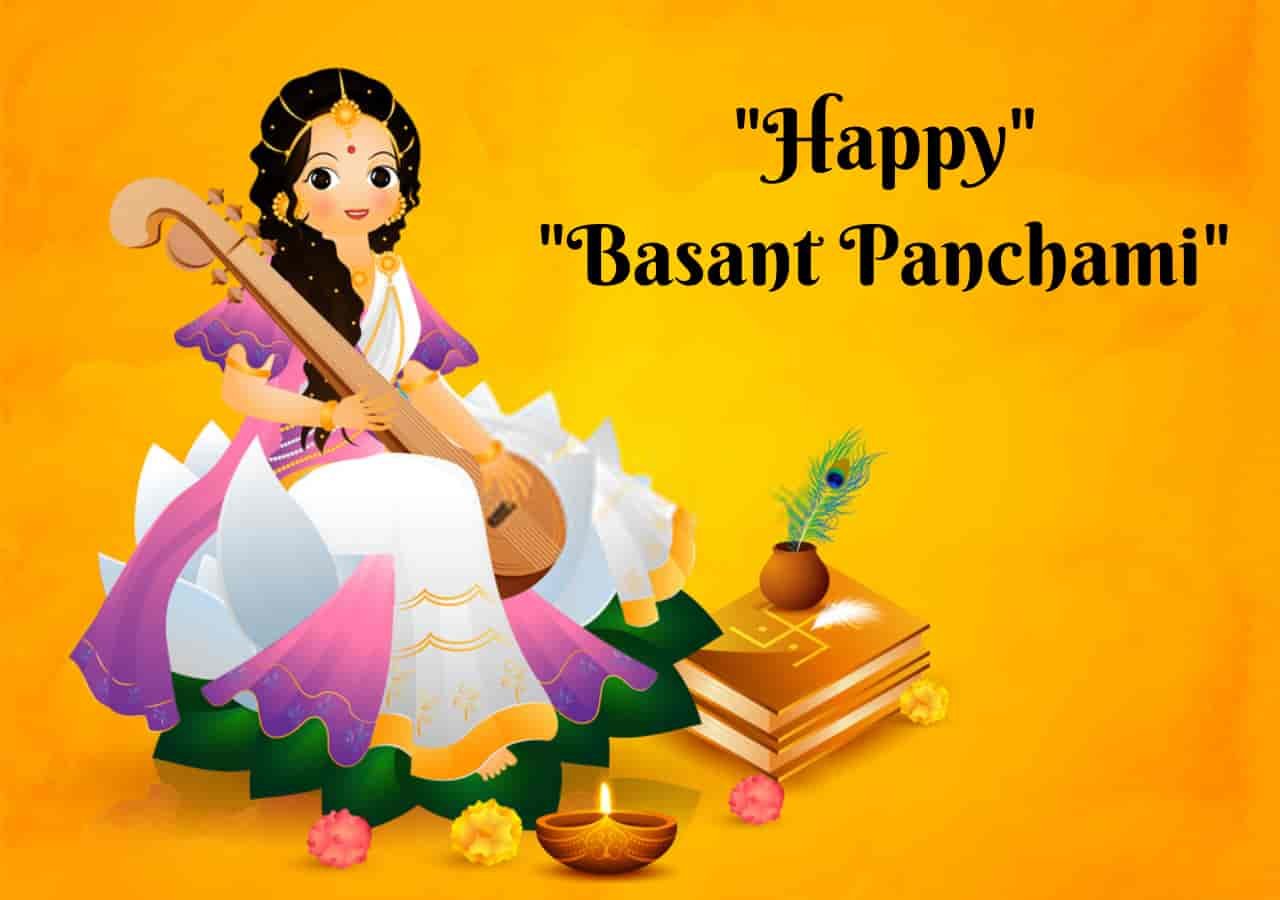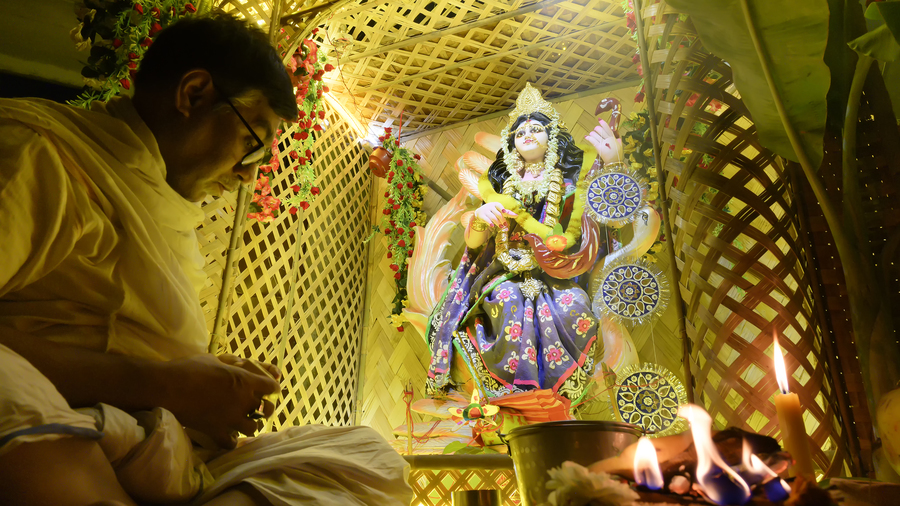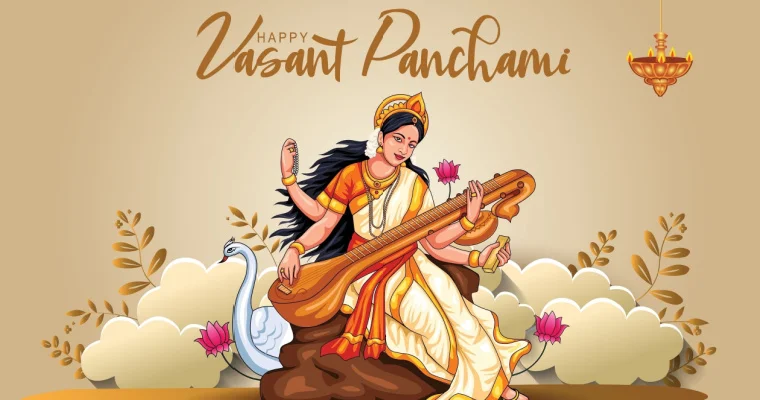Basant Panchami, the festival heralding the onset of spring, is a jubilant celebration that occupies a special place in India’s vibrant tapestry of festivals. With winter’s chill receding and nature bursting forth in a riot of colors, Basant Panchami, celebrated on the fifth day of the month of Magha in the Hindu calendar, symbolizes renewal, hope, and the invigorating energy of the coming season.
More than just a seasonal festival, the day holds profound spiritual significance, particularly as a day dedicated to Goddess Saraswati, the deity of knowledge, music, arts, and wisdom. For countless devotees, this festival becomes a confluence of nature’s rebirth and a deep reverence for the divine source of knowledge and creativity.

In the vast cultural diversity of India, the essence of Basant Panchami remains consistent – it’s a day to welcome the refreshing spring and honor the divine blessings of Goddess Saraswati. Whether it’s students placing their books at the feet of Saraswati for her blessings or artists invoking her grace for inspiration, the undercurrent of devotion and gratitude is palpable.
As we approach Basant Panchami in 2024, it’s both a moment of reflection and anticipation. This blog aims to provide readers with insights into the rituals, the auspicious timings (muhurat), and the deeper meanings embedded in this beloved festival. Whether you’ve been a lifelong celebrant or are newly curious about the festivities, join us on this enlightening journey into the heart of Basant Panchami and Saraswati Puja.
Historical Context of Basant Panchami and the Worship of Goddess Saraswati
Basant Panchami, as the name suggests, is celebrated in the heart of spring (‘Basant’ meaning spring). The festival’s antiquity is rooted deep within the annals of Indian civilization, making it a timeless celebration passed down through millennia.
1. Ancient References:
Ancient scriptures and texts like the Rigveda contain hymns dedicated to Goddess Saraswati, attesting to her veneration from Vedic times. She was revered not only as the goddess of rivers and purity but also as the deity symbolizing knowledge, enlightenment, and artistic proficiency.
Archaeological discoveries, such as seals from the Indus Valley Civilization, suggest the existence of a river deity, which many scholars associate with the early forms of Goddess Saraswati.
2. Mythological Tales:
According to popular beliefs, Goddess Saraswati, born from the thoughts of Lord Brahma (the creator), dispelled the chaos and gave him knowledge to create the universe. This tale underscores the essential role of knowledge in creation and existence.
Another legend narrates the story of how Saraswati’s wisdom helped Lord Krishna defeat the demon Shukracharya. Such tales exemplify the goddess’s pivotal role in aiding the forces of good over evil.
3. Evolution of the Festival:
Over time, as agrarian societies developed, Basant Panchami began to symbolize the season of harvest and abundance. Farmers prayed to Saraswati for a bountiful yield and prosperity.
Educational institutions, especially in ancient centers of learning like Nalanda and Taxila, considered Basant Panchami a paramount occasion, initiating new students into the world of learning with the blessing of Goddess Saraswati.
4. Geographical Expansions:
While the origins of Basant Panchami can be traced back to the northern regions of India, over centuries, its influence expanded across the subcontinent. Different regions adapted the festival to their local customs and traditions, leading to the diverse celebrations we witness today.
In essence, the historical context of Basant Panchami offers a window into its deep-seated significance in Indian culture. From the reverence of Goddess Saraswati in ancient scriptures to the festival’s evolution in agrarian societies, Basant Panchami’s journey through time celebrates the undying spirit of renewal, both of nature and human intellect.
Basant Panchami 2024 Date & Muhurat

Vasant Panchami is celebrated on the fifth day of Magh by the Hindu calendar. This year it falls on February 14. The festival is also known as ‘Sarasvati Puja’ and marks the beginning of Spring.
Rituals and Traditions of Basant Panchami and Saraswati Puja
The celebration of Basant Panchami and Saraswati Puja is steeped in rich traditions and rituals that have been passed down through generations. These customs not only evoke feelings of nostalgia but also provide a spiritual framework to connect with the divine.
1. Preparations for the Puja:
- Purification: Before beginning the rituals, many people take a holy bath early in the morning to purify themselves.
- Altar Setup: A dedicated space is cleaned and adorned with colorful rangoli or alpana. A white cloth is spread out, upon which the idol or picture of Goddess Saraswati is placed.
2. Pran Pratishtha:
This ritual involves invoking the goddess’s presence in the idol or image. Sacred chants and mantras are recited to invite Goddess Saraswati to accept the devotee’s offerings and prayers.
3. Pushpanjali (Floral Offering):
Devotees offer a mixture of flowers, mainly marigolds and jasmine, to the goddess while reciting the Saraswati mantra.
4. Offerings to the Goddess:

- Fruits: Mangoes, bananas, and other seasonal fruits are offered.
- Sweets: Traditional sweets like kesari, modak, and basundi are prepared and presented to the goddess.
- Cloth: Some devotees offer a white or yellow piece of cloth to the goddess, symbolizing purity and wisdom.
5. Akshar-Abhyasam or Vidyarambham:
This is a significant ritual, especially for young children who are introduced to formal education. They are made to write their first letters on this auspicious day, seeking blessings for a successful academic life.
6. Artistic Performances:
Given Saraswati’s association with arts and music, many cultural programs and recitals are held on this day. Devotees sing devotional songs and hymns in praise of the goddess.
7. Immersion (Visarjan):
In regions where a clay idol of Goddess Saraswati is worshiped, a visarjan ceremony (immersion of the idol in water) concludes the festivities.
8. Fasting and Feasting:
While some devotees opt to fast until the puja is complete, many indulge in festive meals after the rituals, enjoying traditional dishes and sweets.
9. Dressing in Yellow:
As yellow represents the blooming mustard fields of spring, many people, especially in North India, don yellow garments to mark the festival.
10. Flying Kites:
Especially popular in Punjab and parts of North India, flying kites on Basant Panchami is a joyous tradition, symbolizing freedom and the soaring spirit of spring.
These rituals and traditions of Basant Panchami and Saraswati Puja provide a structured approach to express gratitude, seek blessings, and immerse oneself in the spiritual ambiance. Whether conducted at grand public gatherings or intimate home settings, these customs connect devotees to a shared heritage and the timeless blessings of Goddess Saraswati.
Other Aspects of Basant Panchami
While Basant Panchami is primarily known for the worship of Goddess Saraswati, the festival encompasses a plethora of cultural, agricultural, and seasonal aspects that mark its significance across different regions of India.
1. Agricultural Significance:
- Symbol of Harvest: Basant Panchami marks the onset of the spring season. Farmers prepare their fields for the Rabi (spring) harvest. The blooming mustard fields, covered in a yellow blanket, are a classic sight of this time.
- Prayers for Abundance: Farmers seek blessings for a bountiful harvest. Special rituals are often performed in the fields, praying for nature’s benevolence.
2. Cultural Celebrations:
- Festive Melodies: Music plays a vital role in the celebrations. From classical ragas dedicated to the season to popular folk tunes, the air resonates with melodies.
- Dance: Traditional dances, especially in Punjab with the ‘Bhangra’, celebrate the joyous mood of spring and the impending harvest.
3. Culinary Delights:
- Seasonal Produce: Dishes made from fresh spring produce, such as peas, carrots, and mustard greens, are relished.
- Special Sweets: Many regions prepare specific sweets for the occasion. Punjab’s famous ‘Sarson da Saag and Makki di Roti’ and Bengal’s ‘Bhapa Pitha’ are prime examples.
4. Spiritual Overtones Beyond Saraswati Puja:
In some regions, especially in Bihar and Bengal, it’s also considered auspicious to worship Lord Shiva and Parvati alongside Goddess Saraswati.
In certain South Indian communities, Kamadeva, the god of love, is honored on Basant Panchami, highlighting the romantic undertones of the spring season.
5. Educational Significance:
Apart from the ceremonial initiation of children into the world of learning (Vidyarambham), many academic institutions organize special functions, debates, and seminars to honor Goddess Saraswati, the symbol of knowledge.
6. Kite Flying:
In states like Punjab and Haryana, the skies are dotted with colorful kites, as kite flying competitions become the highlight of the day.
7. Spring Fashion:
The festival sees people of all ages donning vibrant spring colors, especially yellow and white, echoing nature’s fresh palette.
8. Holistic Health:
Ayurveda, the traditional Indian system of medicine, recognizes the transitional phase of seasons as crucial for health. Specific dietary and lifestyle changes are recommended during this time to ensure well-being throughout the year.
In essence, Basant Panchami transcends religious rituals to encapsulate a broader celebration of life, nature, and culture. Its multifaceted significance reflects the intricate tapestry of India’s diverse traditions, making it a festival that resonates with people from all walks of life.

Basant Panchami, with its myriad hues of celebration, stands as a vibrant testimony to India’s rich tapestry of culture, traditions, and spirituality. While the worship of Goddess Saraswati remains central to its observance, the festival effortlessly weaves together strands of agricultural gratitude, seasonal shifts, educational milestones, and the sheer joy of spring’s arrival.
Whether it’s the fragrant offerings at the feet of the divine, the joyful flight of kites painting the sky, or the harmonious tunes celebrating nature’s rebirth, each aspect of Basant Panchami holds a mirror to the country’s age-old values and the timeless rhythm of its seasons.
As we reflect upon the diverse facets of this festival, we are reminded of the cyclical beauty of nature and the eternal dance of the cosmos. And in this dance, traditions like Basant Panchami serve not just as markers of time, but as anchors grounding us in gratitude, wisdom, and unity.

